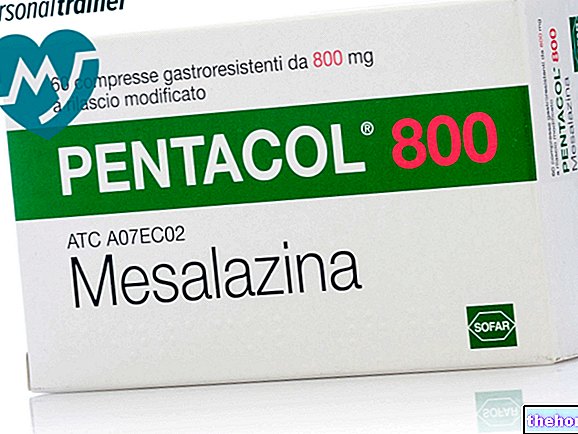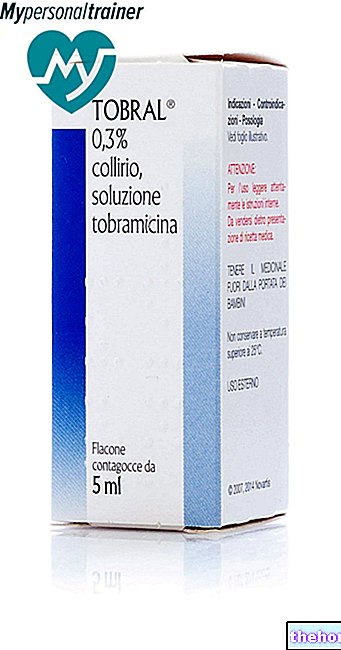Active ingredients: Calcipotriol
CALCIPOTRIOL SANDOZ 0.05 mg / g ointment
Why is Calcipotriol used - Generic drug? What is it for?
Calcipotriol Sandoz is used on the skin for the topical treatment of mild to moderately severe forms of psoriasis (psoriasis vulgaris).
Psoriasis is a condition that occurs when skin cells are produced too quickly, causing peeling and redness. This ointment helps to restore the rate at which skin cells are produced to normal values.
Contraindications When Calcipotriol should not be used - Generic drug
Do not use Calcipotriol Sandoz:
- If you are allergic (hypersensitive) to the active substance calcipotriol or to any of the ingredients (see section 6 for a full list of excipients).
- If you have a calcium metabolism disorder or if the calcium level in your body is too high. This ointment can increase calcium levels in the blood.
Precautions for use What you need to know before taking Calcipotriol - Generic drug
- The use of this ointment for children and adolescents (under 18 years) is not recommended as clinical experience is not sufficient to justify its use in these patients.
- This ointment can cause skin irritation. Wash your hands after applying the ointment. Also remove any product that may have spread to healthy portions of the skin.
- Do not apply it on your face.
- If you use a lot of Calcipotriol Sandoz for a long time or more than 100g in a week, you may experience an increase in blood calcium levels. This can cause for example tiredness, nausea, loss of appetite and constipation (see also section 3).
- Do not apply it concomitantly with topically applied salicylic acid
- Do not cover the treated area with a waterproof bandage
- If you use it in conjunction with UV therapy, dark areas may appear on the skin (hyperpigmentation), but this will disappear when the treatment is finished.
Interactions Which drugs or foods can modify the effect of Calcipotriol - Generic drug
If you are using Calcipotriol Sandoz concomitantly with other forms of psoriasis treatment (phototherapy, topical corticosteroids, cyclosporine or acitretin), your doctor will advise you when to use the ointment.
Do not apply a cream or ointment that contains salicylic acid to the parts of the skin where this ointment has been applied, as it breaks down the active ingredient in this ointment.
If you are taking or have recently taken any other medicines, even those without a prescription, please tell your doctor or pharmacist.
Warnings It is important to know that:
Pregnancy and breastfeeding
Due to the lack of available information, avoid using it during pregnancy. It is not known whether calcipotriol is excreted in human milk, therefore its use should also be avoided during breastfeeding. If you are pregnant or breast-feeding, or if you become pregnant while using this ointment, please inform your doctor.
Ask your doctor or pharmacist for advice before taking any medicine.
Driving and using machines
No effect on the ability to drive and use machines is expected.
Important information about some of the ingredients of Calcipotriol Sandoz
This ointment contains propylene glycol, a substance that can cause skin irritation.
Dose, Method and Time of Administration How to use Calcipotriol - Generic drug: Posology
Adults
Dosage:
Always apply this ointment following your doctor's instructions exactly. If you are unsure, you should consult your doctor or pharmacist.
Do not apply more than 100g of this ointment per week. If you apply it concomitantly with a cream or solution that contains calcipotriol, the total amount per week of calcipotriol should not exceed 5 mg
Method and route of administration:
Calcipotriol Sandoz is intended for use on the skin (cutaneous use).
Before using this ointment, wash your hands. Then remove the screw cap and check that the seal is intact before using the ointment for the first time. In the case of a 30g or 120g tube, you will need to break the seal using the tip on the back of the cap. "ointment on a finger or on a portion of skin affected by psoriasis. Apply the ointment by spreading a thin layer of it on the affected areas of the skin. Rub it lightly until the entire area is covered. Do not apply this ointment to your face (see also section 4).
After applying this ointment, wash your hands thoroughly, unless you are treating a form of psoriasis that affects your hands. Try not to transfer the ointment from the treated areas to other areas of the body, especially the face. .
If you are using a moisturizer, apply it first and wait for it to be fully absorbed before applying this ointment.
Frequency of administration:
As monotherapy:
For best results, apply this ointment twice a day, once in the morning and once in the evening. Depending on your response to treatment, your doctor may prescribe only one application per day.
As a combination therapy:
If you are using Calcipotriol Sandoz concomitantly with other forms of psoriasis treatment, your doctor will advise you when and how often to use this ointment.
Duration of treatment:
A first improvement may appear after about two weeks of treatment. The first symptoms to go away are usually flaking or flaking. This will make the psoriasis patches thinner to the touch. The disappearance of skin redness takes longer. Generally the maximum effect is reached after 4-8 weeks.
Children under the age of 18
Calcipotriol Sandoz is not recommended for children and adolescents (below 18 years), as there is limited experience with this ointment in these patients.
If you forget to use Calcipotriol Sandoz
If you forget to use this ointment at the prescribed time, do so as soon as you remember, then continue treatment as prescribed.
Do not use more than normal ointment to make up for a forgotten dose.
If you wish to stop treatment with Calcipotriol Sandoz
If you intend to stop treatment, please consult your doctor first.
If you have any further questions on the use of this medicine, ask your doctor or pharmacist
Overdose What to do if you have taken an overdose of Calcipotriol - Generic Drug
If you have applied more ointment than the prescribed dose (more than 100 g per week), please inform your doctor. Excessive dosage can cause blood calcium levels to rise, which in turn could cause symptoms such as nausea, loss of appetite, constipation, vomiting, muscle weakness, loss of energy, fatigue and loss of consciousness.
Side Effects What are the side effects of Calcipotriol - Generic drug
Like all medicines, Calcipotriol Sandoz can cause side effects, although not everybody gets them.
Undesirable effects occur in approximately 15% of patients. The most frequently observed side effects are transient skin reactions of various kinds.
Common side effects (affecting more than 1 in 100 but less than 1 in 10 patients) are: itching, skin irritation, stinging and burning sensation, dry skin, redness and rash.
Uncommon side effects (ie affecting more than one in 1000 but less than one in 100 patients) are: contact dermatitis, eczema and aggravated forms of psoriasis.
Very rare side effects (affecting less than 1 in 10,000 patients) are: high level of calcium in the blood and urine, allergic reactions including hives, swelling of the face, eyelids, hands, feet or throat, transient changes skin color, transient increase in skin sensitivity to light.
Applied by mistake to the face, the ointment can cause redness or irritation of the skin on the face or around the mouth.
If any of the side effects gets serious or lasts for a long time, or if you notice any side effects not listed in this leaflet, please tell your doctor or pharmacist.
Expiry and Retention
Keep this medicine out of the reach and sight of children.
Do not use it after the expiry date, which is stated on the tube and on the carton. The expiry date refers to the last day of the month.
After 3 months from the first opening of the tube, the contents must no longer be used.
Do not store above 25 ° C. Do not refrigerate or freeze. Keep the product in the original packaging.
Medicines should not be disposed of via wastewater or household waste. Ask your pharmacist how to throw away medicines you no longer use. This will help protect the environment.
Other information
What Calcipotriol Sandoz contains
The active ingredient is calcipotriol. One gram of ointment contains 0.05 mg of calcipotriol (an amount equivalent to 50 micrograms).
The ingredients are: macrogol stearyl ether, disodium edetate, disodium phosphate dihydrate, alpha-tocopheryl acetate, propylene glycol (E 490), light liquid paraffin, purified water and white soft paraffin.
What Calcipotriol Sandoz looks like and contents of the pack
Its ointment is white to pearl gray in color. The ointment is available in tubes of 30 and 120 grams.
Not all pack sizes may be marketed.
Source Package Leaflet: AIFA (Italian Medicines Agency). Content published in January 2016. The information present may not be up-to-date.
To have access to the most up-to-date version, it is advisable to access the AIFA (Italian Medicines Agency) website. Disclaimer and useful information.
01.0 NAME OF THE MEDICINAL PRODUCT
CALCIPOTRIOLO SANDOZ
02.0 QUALITATIVE AND QUANTITATIVE COMPOSITION
One gram of ointment contains 0.05 mg (corresponding to 50 mcg) of calcipotriol.
Excipient: propylene glycol 10 mg / g.
For the full list of excipients, see section 6.1.
03.0 PHARMACEUTICAL FORM
White to pearl gray ointment.
04.0 CLINICAL INFORMATION
04.1 Therapeutic indications
Calcipotriol Sandoz is indicated for the topical treatment of psoriasis (psoriasis vulgaris) in mild to moderately severe forms.
04.2 Posology and method of administration
Adults
As monotherapy
Calcipotriol Sandoz should be applied to the affected portion of the skin once or twice a day. At the beginning of the treatment it is recommended to apply the ointment twice a day. For maintenance therapy, the frequency of applications can be reduced to once a day, depending on the response.
The maximum amount of applied ointment should not exceed 100 g per week. If Calcipotriol Sandoz is used together with another cream or solution containing calcipotriol, the total weekly dose of calcipotriol should not exceed 5 mg.
As a combination therapy
Both therapies based on two daily applications of Calcipotriol Sandoz in combination with phototherapy, acitretin and cyclosporine, and those based on a single daily application of Calcipotriol Sandoz together with topical corticosteroids (consisting for example of the application of Calcipotriol Sandoz) are effective and well tolerated. in the morning and steroid in the evening).
The duration of therapy depends on the clinical aspect. In general, a particularly relevant therapeutic effect occurs after a maximum of 4-8 weeks. The therapy can be repeated.
Impaired renal and / or hepatic function
Patients with known severely impaired renal and / or hepatic function should not be treated with calcipotriol.
Children and adolescents (under 18 years of age)
There is limited experience with the use of Calcipotriol Sandoz in children and adolescents (under 18 years of age). In children and adolescents, the long-term efficacy and safety of the dosage indicated above (in paragraph Adults) has not been proven. Therefore, use in this population is not recommended.
04.3 Contraindications
• Hypersensitivity to the active substance (calcipotriol) or to any of the excipients.
• Known disorders of calcium metabolism.
• Hypercalcemia.
04.4 Special warnings and appropriate precautions for use
Calcipotriol Sandoz should not be used on the face.
Patients should be instructed to wash their hands after application to avoid inadvertent transfer of the ointment to other areas, particularly the face.
The long-term efficacy and safety of this ointment in children has not been proven.
At usual dosages (up to 100 g per week) hypercalcemia does not occur. Excessive use (50-100 g of ointment per day) can cause increases in serum calcium levels, a trend that quickly reverses at the end of treatment. . A series of studies conducted in adults over the course of a year has not produced any evidence for the existence of the risk of hypercalcemia. However, in the case of long-term therapies with applications on large areas of the skin, it is necessary to monitor the serum calcium level. .
In view of the possible effects on calcium metabolism, patients should be advised not to exceed the prescribed dose (see section 4.2), and that the addition of penetrating substances (such as salicylic acid) to the ointment is not For the same reason, occlusion should also be avoided.
Depending on their intensity and duration, the clinical symptoms of hypercalcaemia - for example hypercalcemic syndrome or calcium intoxication (see section 4.9) - may resemble those of a cholecalciferol overdose.
A persistent form of hypercalcemia can cause ectopic calcium deposits on blood vessel walls, joint capsules, gastric mucosa, cornea and renal parenchyma.
According to some data, the combination of calcipotriol with UV light can give rise to dark areas of hyperpigmentation, an effect however reversible. If calcipotriol is started during UV-B therapy, a form of photosensitive eczema may develop.
In view of the limited experience available, patients with known severely impaired renal and / or hepatic function should not be treated with Calcipotriol Sandoz.
Calcipotriol Sandoz contains propylene glycol. It can cause skin irritation.
04.5 Interactions with other medicinal products and other forms of interaction
Although the studies conducted so far have shown that the concomitant use of Calcipotriol Sandoz with UVA therapy or with cyclosporine or acitretin is effective and well tolerated, there are insufficient data to show that the combination is more efficient or that the dosage of other medicinal products can be reduced.
The ointment does not increase the overall effectiveness of the UV-B treatment. However, when used in conjunction with a UV-B treatment on adult patients, it reduces the amount of irradiation required, allowing for a clinical response to lower amounts of UV-B. Calcipotriol Sandoz should be applied at least two hours before UV-B treatment. The combination of calcipotriol with UV-B light could result in dark areas of hyperpigmentation as well as photosensitive eczema (see section 4.4). The ointment should not be used if the patient is already receiving an erythemogenic or sub-erythemogenic dose of UV-B. Concomitant administration of calcipotriol and other salicylic acid medications may result in the inactivation of calcipotriol. There is no experience with concomitant therapy of calcipotriol and other antipsoria products applied simultaneously in the same skin area.
04.6 Pregnancy and breastfeeding
Pregnancy
For calcipotriol, no data are available in pregnant patients. After local application of Calcipotriol Sandoz to restricted skin areas, limited absorption can be expected. If the ointment is used as directed, no form of disturbance in calcium homeostasis is expected. Regarding reproductive toxicity, animal studies do not indicate any direct or indirect harmful effects. As a precautionary measure, it is preferable to avoid the use of calcipotriol during pregnancy.
Feeding time
It is not known whether calcipotriol is excreted in human milk or not. The excretion of calcipotriol in milk has not been studied in animals. As a precautionary measure, it is preferable to avoid the use of calcipotriol during lactation.
04.7 Effects on ability to drive and use machines
By virtue of the nature of the product and the indications for its use, it does not affect the ability to drive and use machines.
04.8 Undesirable effects
In light of the available clinical data, undesirable effects occur in approximately 15% of patients.
The most frequently observed undesirable effects consist of transient skin reactions of various kinds, which occur in particular at the application site and which rarely require treatment interruption.
Undesirable effects are listed below by system organ class (SOC) according to MedDra terminology; single undesirable effects are indicated starting with those most frequently reported.
Skin and subcutaneous tissue disorders
Common (> 1/100 e: itching, skin burning sensation, stinging sensation, skin irritation, dry skin, erythema, rash *
Uncommon (> 1/1000 and: eczema, contact dermatitis, aggravated psoriasis.
* Different forms of skin rash have been observed, for example squamous, erythematous, maculo-papular and pustular types.
Metabolism and nutrition disorders
Very rare (: hypercalcemia, hypercalciuria.
The following undesirable effects caused by calcipotriol in the form of scalp cream, ointment and solution have been observed during post-marketing experience: transient changes in skin pigmentation, transient photosensitivity and hypersensitivity reactions, including urticaria, angioedema , periorbital or facial edema (very rarely). In rare cases, perioral dermatitis may occur. Based on post-marketing data, the total reported undesirable effect rate of approximately 1: 10,000 treatment cycles is considered very rare.
04.9 Overdose
Up to now, at a normal dosage (up to 100 g of ointment per week), no form of hypercalcaemia has been observed in patients with psoriasis vulgaris, although the possibility that hypercalcaemia occurs at this dosage cannot be completely excluded. Excessive use (50-100 g per day) can cause a rise in the calcium level, which rapidly decreases once treatment is terminated; at lower doses, cases of hypercalcaemia have been observed in patients with generalized pustular or erythrodermal exfoliative psoriasis. Symptoms of hypercalcemia include anorexia, nausea, vomiting, constipation, hypotonia, depression, lethargy and coma.
05.0 PHARMACOLOGICAL PROPERTIES
05.1 Pharmacodynamic properties
Pharmacotherapeutic group: other antipsoriatic drugs for topical use, ATC code D05AX02
Calcipotriol is a derivative of vitamin D. Studies in vitro show that calcipotriol induces differentiation and stops the proliferation of keratinocytes. The effect of calcipotriol on psoriasis is mainly due to these two properties.
The first effects, first of all on desquamation, then on infiltration and finally on erythema, are visible after a treatment period ranging from two to four weeks. The maximum effect is usually achieved after six weeks.
05.2 Pharmacokinetic properties
Data from a single study in five psoriasis patients treated with 0.3-1.7 g of a 50 mcg / g tritium-labeled calcipotriol ointment suggest that less than 1% of the indicated dosage was absorbed. .
However, the total recovery of the labeled tritium over a period of 96 hours ranges from 6.7 to 32.6%, figures maximized by incorrect chemiluminescence. There was no evidence of tissue distribution or lung excretion.
05.3 Preclinical safety data
There are no other preclinical data considered relevant to clinical safety other than those included in other sections of the SmPC.
06.0 PHARMACEUTICAL INFORMATION
06.1 Excipients
• Macrogol stearyl ether.
• Disodium edetate.
• Disodium phosphate dihydrate.
• Alpha-tocopheryl acetate.
• Propylene glycol (E 490).
• Light liquid paraffin.
• Purified water.
• White soft paraffin.
06.2 Incompatibility
Not relevant.
06.3 Period of validity
2 years.
After first opening: 3 months.
06.4 Special precautions for storage
Do not store above 25 ° C.
Do not refrigerate or freeze.
Store in the original packaging.
06.5 Nature of the immediate packaging and contents of the package
Aluminum tube closed by a membrane with a polyethylene screw cap.
Pack sizes: 30, 120 grams.
Not all pack sizes may be marketed.
06.6 Instructions for use and handling
No special instructions.
07.0 MARKETING AUTHORIZATION HOLDER
Sandoz S.p.A. - Largo U. Boccioni, 1 - 21040 Origgio (VA)
08.0 MARKETING AUTHORIZATION NUMBER
0.05 mg / g ointment, 1 tube of 30 g - A.I.C. n. 037726015 / M
0.05 mg / g ointment, 1 tube of 120 g - A.I.C. n. 037726027 / M
09.0 DATE OF FIRST AUTHORIZATION OR RENEWAL OF THE AUTHORIZATION
August 2007
10.0 DATE OF REVISION OF THE TEXT
February 2008




























